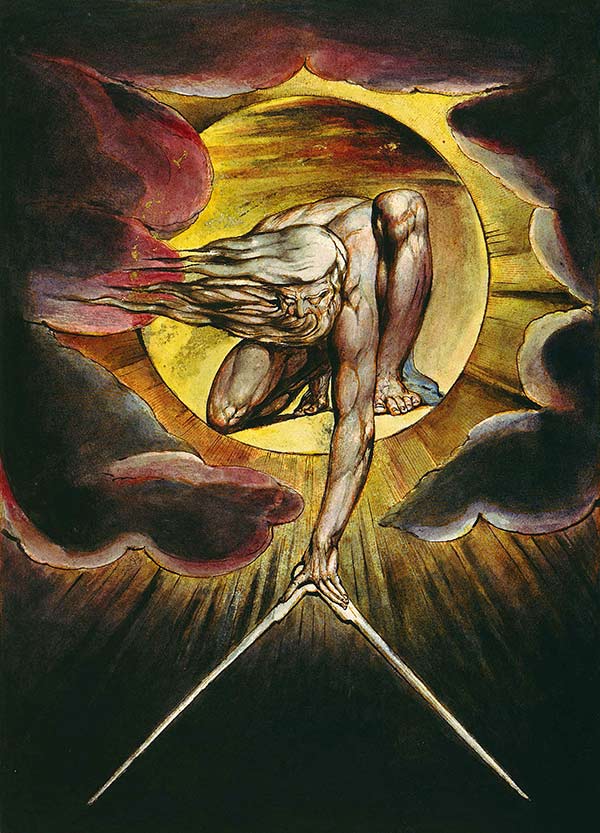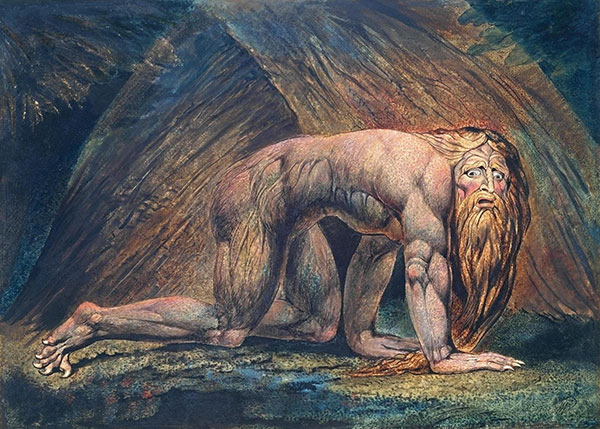Subtotal: $
Checkout
Why We Need William Blake
Blake’s art and life are testaments to a prophetic artist unbound by traditional constraints and unwilling to compromise truth.
By Arthur Aghajanian
January 30, 2024
The notion of the artist as prophet is a familiar motif. Once you recognize art’s spiritual dimension, it’s easy to see how both artists and prophets can be catalysts for change, communicators of truth, boundary breakers, inspired messengers, and agents of transformation. After all, both artists and prophets envision alternative narratives and challenge established norms. And each has the capacity to communicate profound insights through the use of imaginative expression. The artist with a prophetic vision calls attention to unseen truths and potential futures.
Few artists embody the prophetic figure or possess an imagination like William Blake (1757–1827). Yet the art world, with its secular orientation, is more comfortable with the term “visionary.” So it came as no surprise that the recent exhibition of his work at the Getty Center in Los Angeles bore the title William Blake: Visionary. The timing of its arrival was ideal for a city, and indeed a nation, wrestling with internal conflict and social malaise.
Artists can shed light on their society’s most pressing issues. Blake demonstrates how an artist, positioned on the fringes of mass culture, can upset the prevailing order by making the invisible visible and the familiar unfamiliar.
Featuring over one hundred of the artist’s works, William Blake: Visionary provides an overview of his central themes, highlighting diverse aspects of his prophetic vision and his imaginative approach. The drawings, engravings, and paintings are organized into five themes. The “Professional Printmaker” and “Independent Artist” galleries showcase his early development as a printmaker and how he diverged from the conventional artistic norms of his time. The “Inventor” galleries feature works made through the relief etching process that Blake originated and which allowed him to merge poetry and image in his acclaimed “illuminated books.” The “British Art World” section contextualizes him in relation to his contemporaries, the Royal Academy of Arts, and the London art world of his time. The show culminates in the “Visionary” section, which includes some of his best-known works and “prophetic books.”
Though William Blake is often overlooked today, he has undeniably left a lasting mark on the history of Western art and poetry. He rejected the Enlightenment and industrialization. Associated with the Romantic movement, he shared the artistic landscape with luminaries like William Wordsworth and J. M. W. Turner. His work was infused with a mysterious, otherworldly, and fantastical quality. Throughout the exhibition, a pantheon of deities and celestial beings weave through allegorical narratives. Although his figures inhabit strange worlds, their depiction leans toward classical aesthetics, characterized by sculpted musculature and idealized features. Blake was influenced by Renaissance masters like Michelangelo, Raphael, and Durer. He illustrated canonical works of literature, drew inspiration from the Bible, and enriched his own poetry with enigmatic drawings.
The Getty exhibition includes a number of significant pieces. Among them are a rare edition of his illuminated book, America a Prophecy – his interpretation of the American Revolution – and pages from his epic poem Milton. Color impressions from Songs of Innocence and Experience, a collection of illustrated poems, include his renowned work The Tyger. His painting The Ghost of a Flea takes the final space of the exhibition. It’s an image based on one of Blake’s visions – a recurring experience for the artist – portraying a bizarre vampiric creature. The painting is both terrifying in its intensity and innovative in its execution through the use of tempera and gold leaf.

William Blake, The Ancient of Days, etching, pen, ink, watercolor, on paper, 1794.
Among the exhibition’s highlights is The Ancient of Days (1794), the image that William Blake’s name evokes for many. It’s easy to assume that the stern, white-bearded figure is a depiction of a displeased Old Testament God, or perhaps Zeus, crouched in the sky and blasting the earth with lightning bolts. In fact, it’s a depiction of the artist’s mythological character Urizen, who represents conventional reason and law. He is shown kneeling on a flaming disk as he measures and divides the universe with a golden compass. He embodies the Enlightenment and is thus, for Blake, the enemy of imagination.
A large color print with the addition of ink and watercolor, Nebuchadnezzar (1795–1805) looks like a werewolf that has leapt off the pages of a contemporary graphic novel. It illustrates an event in the Book of Daniel in which the king of Babylon is punished by God for his pride and transformed into a wild beast. Nebuchadnezzar crawls on his hands and knees, a mix of terror and sorrow on his face as his talons rake the earth and his long beard sweeps the ground. His muscles and sinews have a life of their own. His very form, a desperate cage for unleashed savagery, appears to morph before our eyes.
Blake’s imagination is evident in his distinctive aesthetics and innovative methods, but also in his societal role and political stance as a resister. Both his art and his life are testaments to an artist unbound by traditional constraints and unwilling to compromise truth.
His visual art is an amalgamation of diverse influences. Drawing from a range of sources including ancient, Gothic, and Renaissance art; children’s illustration; and commercial signs, he imaginatively reconceived biblical narratives and representations of contemporary social and political issues. His art reflected a unique blend of spiritual vision, creative genius, and commentary on the human condition. Through his method of “relief etching,” which allowed him complete control over the books he produced, Blake wrote verses, designed the illustrations, and combined them on a single copper plate. His “illuminated books” combining text and image in complex ways presented his biblically inspired personal mythology, but also took the form of illustrated poetry and lyrics for children.
Radical and distinctive in its era, forward-looking yet somehow timeless, Blake’s art continues to be widely influential. The Getty’s audio guide features commentary by a contemporary artist, a comic book creator, and a scholar.
His critical imagination was also at work in his ongoing rebellion against authority, particularly in his bold challenges to the church of his time. Resistance to institutions relies on imagination for envisioning alternative systems and for sustaining resilience in the face of challenges. Alongside Blake’s idiosyncratic religious visions were a set of equally potent social and political concerns that found him railing against poverty, racial inequality, exploitation, and religious hypocrisy. Spurning the confines of his time, his art and activism became weapons against the rigid order of the status quo, the British art establishment, and the church.
His expressive visual vocabulary invites a reengagement with the Christian tradition, offering a visionary perspective that seeks God both in the familiar and in the unknown. His art and poetry inspire viewers to undertake that spiritual journey alongside him.
And how did Blake envision Jesus and the kingdom of God? Stepping away from more common interpretations, he paints a revolutionary portrait of Jesus, one that challenges us to confront the injustices of our own time. He believed institutional religion had coopted Jesus, using him to consolidate its own power and influence. But he did eventually turn to Jesus as the figure who could redeem humanity from the void, absorbing us in his ultimate love and elevating us beyond our troubled condition. He saw the sacrifice of Jesus as the giving up of selfhood, not as an appeasement to a wrathful God but as a means of dissolving the ego. For him, Jesus was the champion of the marginalized, the forgotten, the voiceless. Blake felt great resentment toward the church for what he perceived as its indifference to the plight of the ostracized.
Jesus himself put critical imagination to use in his ministry. He sparked empathy through parables, reframed reality with metaphors, and ignited hope through his prophetic visions. Blake loved the Jesus who condemns oppression and inspires us to imagine the kingdom of God within.
Blake’s approach was fundamentally nondual, embracing paradox by recognizing and reconciling apparent contradictions within a unified whole. We live in a world where institutions of politics, media, and consumer culture support an elite class that benefits from division and control. Under such conditions, adopting a nondual perspective becomes a radical act of resistance. To hold seemingly opposing forces in tension – light and shadow, order and chaos – is to see like Blake.
Getting past dualistic mental habits allows us to recognize the interconnectedness of all things. This can lead us, as it did the artist, to become aware of how oppression thrives on manufactured divisions. Blake saw the Church of England as an institution reinforcing the very powers it should oppose. But a church can and should encourage critical imagination that is committed to truth, shared with others, and promoted by the church as a vital force for change. Such imagination equips us to dismantle the walls of division erected by those who profit from our fragmentation.

William Blake, Nebuchadnezzar.
We live in a world of shimmering screens and mediated realities, where corporations dangle distractions and whisper promises of comfort and belonging. In a global environment dominated by the influence of profit motives and market-driven values, we are seen as docile consumers to be lulled into a trance of passive acceptance. Cutting through this fog, William Blake’s visions present another kind of spectacle, one that counteracts the manufactured spectacle of modern society. His images, born of fevered dreams and mystical encounters, are not meant to soothe, but to disturb and awaken.
Blake’s spectacle is not for mindless consumption but for active engagement. It confronts us with the raw power of life, the joy and suffering of the human drama, and the ever-present possibility of transcendence. To understand his art, we must confront our own shadows, peel back the layers of our conditioning, and reclaim our agency as conscious, questioning beings. In the discomfort of the unknown to which his work opens, we rediscover the messy, vital essence of our humanity. It’s a far cry from the packaged version of the self peddled by advertising and promoted through social media.
So, while Blake’s art may be spectacular, it’s not a glittering fog that obscures reality. It’s a portal through which we glimpse our own beasts and angels, as well as chaos and divine order. With Blake these are equally a part of who we are.
Largely unrecognized in his own day, his work had to wait for a world ready to receive its prophetic message. Many Christians in both his own time and ours have been disturbed by controversial aspects of his theology. But Blake’s genius lies in his audacious reimagining of Christianity’s symbols, free of rigid, self-imposed limitations. He invites us to do the same: to revisit our own religious traditions with a receptivity and curiosity that will allow us to find in their riches new meaning to apply to our unique life circumstances. His art points the way to overcoming passive spectatorship. Through its power, we’re called back to be active participants in the spectacular journey of our lives, awake and fully human.
Already a subscriber? Sign in
Try 3 months of unlimited access. Start your FREE TRIAL today. Cancel anytime.







Kim Peters
That was an inspired article. As a professional artist and a Christian, this truly spoke my language and encouraged my soul.
Larry Smith
Well said: “adopting a nondual perspective becomes a radical act of resistance. To hold seemingly opposing forces in tension – light and shadow, order and chaos – is to see like Blake.” Thank you for this synthesis, part of our calling in Jesus’ already but not yet kingdom.